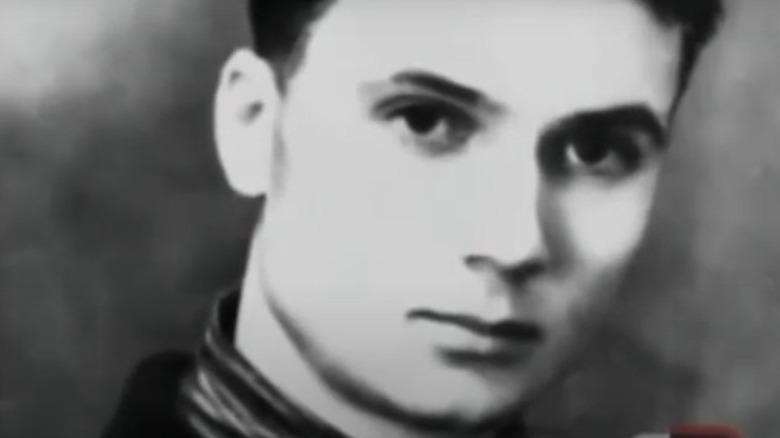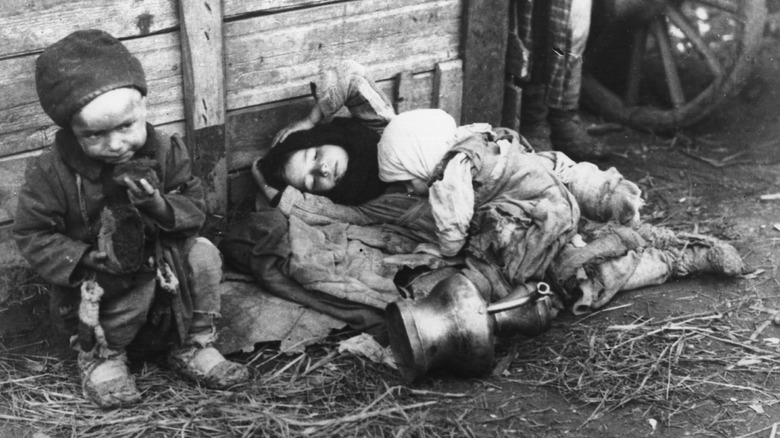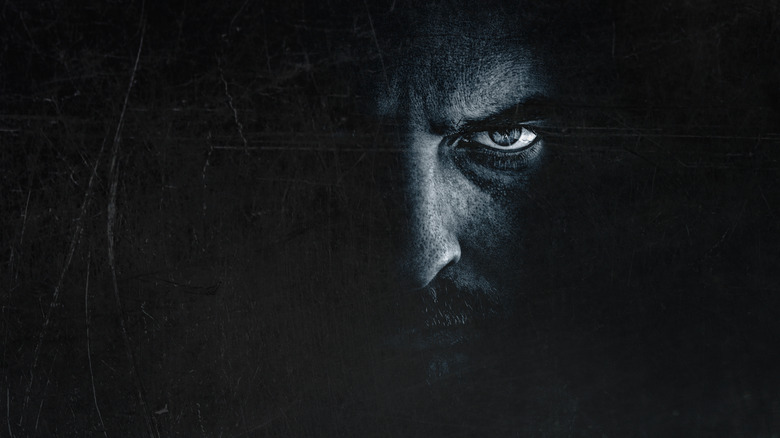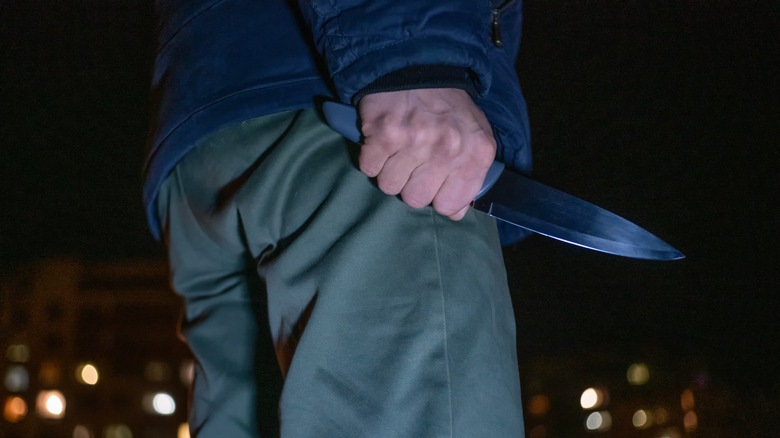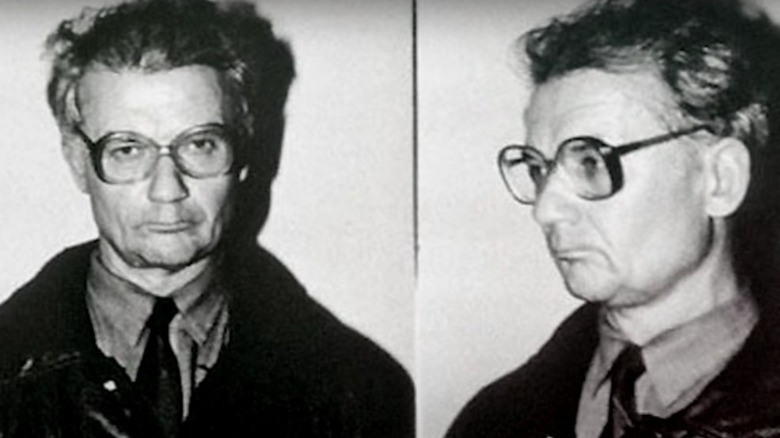Details You Didn't Know About Serial Killer Andrei Chikatilo
(Please note: The following article contains graphic details of violent crimes.)
Soviet serial killer Andrei Chikatilo murdered and mutilated 21 boys, 14 girls, and 18 young women, making him one of the most savage serial killers in history anywhere in the world (per The Los Angeles Times). Nicknamed "the Red Ripper" and "the Butcher of Rostov" (for the area where he committed most of his murders), Chikatilo started killing in 1978 and didn't stop until he was captured in 1990.
Chikatilo found his victims almost everywhere, from train stations to schoolyards to city streets. Some of his victims were sex workers; some were drifters. But he targeted anybody who he thought would follow him into the nearby forests, his preferred killing grounds and the reason why the murders were dubbed the "Forest Strip" killings (per Los Angeles Times).
After he was finally caught in 1990, Chikatilo never showed remorse, but instead told the court that he was "like a crazed wolf" and "a mistake of nature" (via LA Times).
Chikatilo's childhood was grim
Chikatilo was born in 1936 in a small Ukrainian village. At the time of his birth, Ukraine was still going through the aftermath of Holodomor, or Terror-Famine, a calculated effort by Soviet dictator Joseph Stalin to starve the Ukrainian population (via History). Stalin's policies resulted in over 3.9 million deaths, destroyed and deserted farms, and instances of cannibalism.
Growing up, Chikatilo was tormented by his mother with the story of an older brother that had been cannibalized by neighbors, though there's no documentation to corroborate that the brother ever existed (per Britannica). This could have potentially had a direct influence on his murders later on, as he often cannibalized his victims. Chikatilo also suffered from hydrocephalus (water on the brain) at birth, which caused a series of problems as he got older, including bed-wetting (something his mother beat him for) and the inability to sustain an erection (via Biography).
During the early 1940s, the Nazis occupied Ukraine, and Chikatilo lived through bombings and constant fear. After his father, a Soviet soldier, was captured by the Nazis and branded an "enemy of the people," Chikatilo was often berated by the locals for being the son of a traitor (per New Straits Times). As he got older, he developed a sick interest in reading about German prisoners being tortured by the Soviet army, according to Britannica.
Chikatilo tried to live a normal life, but failed horribly
Chikatilo was 42 years old when he committed his first murder, but that doesn't mean he was a model citizen until then. For many years, though, it almost seemed like he tried to be.
After graduating from school, Chikatilo tried to enroll at Moscow State University, but was rejected because of his grades. Instead, he completed mandatory military service before returning to his childhood village and meeting a young woman there, according to Crime+Investigation. It was soon obvious that his troubles with women were just starting. Rumors soon spread around town about his impotence, leading to ridicule and the end of the relationship.
Chikatilo ended up completing a degree in Russian literature and philology and soon obtained a job as a teacher at a boarding school, a job he wasn't particularly good at. While there, he molested two teenage girls and often spied on students while they were changing (via Biography). When the school director asked him to resign, Chikatilo moved on to another school, where he was again accused of molesting several young boys and girls. His teaching career was then over. Though he eventually married and had two children, Chikatilo's descent into darkness had started (per Crime+Investigation).
Somebody else was executed for Chikatilo's first murder
Chikatilo's first documented victim was 9-year-old Yelena Zakotnova. Chikatilo's original intention had been to rape her, but he ejaculated when slashing her with a knife. According to The Los Angeles Times, this solidified the connection between violence and sexual gratification for him and started the killing spree that would last over a decade.
Although Chikatilo had been seen with the victim, his wife provided an alibi, so he was never arrested. The police then focused on Aleksandr Kravchenko, who had a previous conviction for rape. Kravenchko also had an alibi corroborated by several witnesses, but after hours of brutal interrogation, he eventually confessed (per Biography). While he retracted his confession during the trial, he was still found guilty and executed in 1984.
Chikatilo didn't kill again for three years. Why? Perhaps as a result of being so close to getting caught; perhaps because he was trying to resist the urge. By September 1981, long before Kravchenko was executed, Chikatilo had found his next victim.
Chikatilo's murders were so gruesome, the details were kept out of the press
Chikatilo's murders were all sexually motivated, but because he couldn't maintain an erection, he also couldn't physically rape his victims. Instead, he would get sexual relief through violence, stabbing and slashing his victims to death. Before killing his victims, he would also strangle them or fill their mouths with leaves and dirt to stop them from screaming. Sometimes, he would use his teeth to tear pieces of skin and in several cases "he ate the sexual organs, or removed other body parts such as the tips of their noses or tongues" (per Biography).
It didn't take long for the police to figure out there was a serial killer on the loose, as Chikatilo's signature was to slash (and sometimes remove) the eyes of his victims (via The Los Angeles Times). Still, it took a long time for the authorities to admit the existence of a serial killer, and even then, nothing was said to the press about his methods or the kind of victims he targeted.
According to Biography, the public grabbed on to whatever they could to explain the murders, including far-fetched stories of possible werewolf attacks.
Communist ideology helped him evade capture
Chikatilo might have been caught earlier if the authorities had warned the public. For years, however, the Soviet police refused to even acknowledge the existence of Chikatilo, as "serial murder was impossible in a communist society" (per Britannica). There were also rumors that "that police did not solve the crimes for so long because of an internal cover-up to conceal" the mistaken execution of Alexsandr Kravchenko (per The Los Angeles Times). As a result, Chikatilo was able to continue killing and mutilating people without the public knowing he was active.
Chikatilo was first arrested in 1984 after a police officer saw him approaching several young women, but was released almost immediately due to a mistake in blood type identification (per Britannica).
After a job change that required traveling around the country, Chikatilo resumed killing, focusing on much younger victims. By this time, the police had organized 24-hour surveillance at train stations and were regularly patrolling trains for men who would match a composite sketch they had. But Chikatilo had joined the volunteer brigade patrolling the trains, which meant he was able to find out exactly where the police were searching, and he then moved on to continue killing somewhere else (via Comrade Chikatilo).
He was finally caught and arrested in 1990 and confessed after nine days of non-stop interrogation. He was accused of "only" 36 murders, but confessed to 55 and helped the police find the bodies (per The Los Angeles Times). After a trial, he was found guilty and executed in a Moscow prison.
